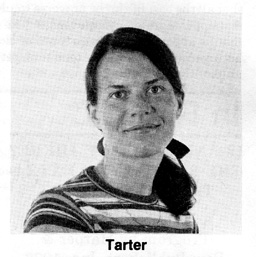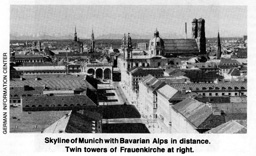 Munich is such a beautiful city and the weather was so brilliant and the beer pastries so delicious that I rapidly forgot about my overly long flight (complicated by hurricane David) and my luggage, which failed to arrive when I did!
Munich is such a beautiful city and the weather was so brilliant and the beer pastries so delicious that I rapidly forgot about my overly long flight (complicated by hurricane David) and my luggage, which failed to arrive when I did!
 This was my first experience with the International Astronautical Federation (IAF) and I was amused to note that the delegates bustled about a bit more than the astronomers with whom I'm used to interacting at international conferences. I did my share of bustling as well; as a substitute for Dr. John Billingham of Ames Research Center, it was my privilege to act as co-chairman of the CETI Symposium along with Dr. Rudolph Pések of the Czechoslovak Academy of Sciences, Prague, Czechoslovakia.
This was my first experience with the International Astronautical Federation (IAF) and I was amused to note that the delegates bustled about a bit more than the astronomers with whom I'm used to interacting at international conferences. I did my share of bustling as well; as a substitute for Dr. John Billingham of Ames Research Center, it was my privilege to act as co-chairman of the CETI Symposium along with Dr. Rudolph Pések of the Czechoslovak Academy of Sciences, Prague, Czechoslovakia.
The CETI Symposium (C for communication instead of S for search) occupied 2 sessions during the 30th IAF Congress. In the morning Dr. Bernard Campbell of the L.S.B. Leakey Foundation, Pasadena, California spoke about the function and nature of terrestrial intelligence charting the formation and growth of undatable memory banks from the most primitive organisms to the present human/digital capability.
Then Dr. Korovin of the USSR read a paper which was to have been presented by Academician Vasevolod S. Troitsky, member of the Intercosmos Council of the Soviet Academy of Sciences. The paper as read was actually the synthesis of two papers which Troitsky himself presented at the SETI Session during the IAU in Montreal this summer. The two main ideas were that there should perhaps be some quantization of the Drake Equation in the sense that life may have been formed in the galaxy over a discrete time interval only and additionally that extremely energetic radio beacons from ETI civilizations are unlikely (Troitsky calls them "Cosmic Miracles"). This latter conclusion follows because construction in orbit in the vicinity of the ETI's home planet must proceed extremely slowly in order to insure that launch of the requisite materials does not become a source of heat/energy pollution for their planetary system.
Dr. Olgierd Wolczek of the Polish Astronautical Society, Warsaw, Poland, followed with a lively discussion of many terrestrial factors such as magnetic field reversal and climatic stability which may have allowed intelligence to evolve on this particular planet. Their absence may have precluded the emergence of intelligent species from multiple life starts elsewhere in the Galaxy.
The morning session concluded with Dr. Charles Seeger of San Francisco State University summarizing the progress which had been made this summer during an American Society for Engineering Education Design Study Program at Ames Research Center. This study group attempted to design a sophisticated signal processor for SETI applications. The design requirements were extreme: 8 million channels of spectral data each second, to be analyzed in as near-real-time as funding allows.
The afternoon session opened with a paper on soft automata by Tibor Ganti of the University of Roland Eotvos in Budapest, Hungary. During the presentation of these ideas on the use of self-replicating, preprogrammed, liquid machines by advanced civilizations wishing to communicate with one another, I detected a singular enthusiasm on the part of one of the delegates in the audience. Therefore I wasn't surprised when Arthur Clarke of Sri Lanka rose to remind us of his own unique speculations along this line in his book "Rendevous with Rama".
Thereafter, it was my turn to present a paper describing SETI observations made in collaboration with Drs. David Black, Jeff Cuzzi and Mark Stull from Ames Research Center, Dr. Thomas Clark from Goddard Space Flight Center and Dr. Frank Drake of Cornell University. We searched 207 nearby solar type stars at frequencies near the 18 centimeter lines of the hydroxy radical (OH) using antennas at the National Radio Astonomy Observatory and at the Arecibo Observatory. Two different schemes were used to achieve high frequency resolution, both of which relied upon high speed tape recorders to collect data for subsequent spectral analysis.
The afternoon session closed with a presentation by David John Richer, of British Aerospace and a student of cybernetics at Chelsea College, University of London. Mr. Richer postulated that an information theoretic approach might help determine a most likely value for "N" (the number of currently communicating technological civilizations in our Galaxy) and in addition assign a meaningful uncertainty to that estimate.
I personally enjoyed all of the sessions of the Congress that I attended. I was delighted to meet Dr. Pések and work with him and the other members of the IAA CETI Committee to plan next year's session in Tokyo. Above all, it was a refreshing change to find myself within an international organization which has long recognized and supported CETI/SETI as a significant and important endeavor.
The only disappointing feature of the meeting was the failure of a large portion of the scheduled Russian delegation to actually attend this Congress. We all would like to know exactly what SETI observations they have completed to date. In the SETI Office at Ames, we receive many Russian papers, but it is difficult to distinguish between proposed and accomplished programs.
 Jill Tarter received a bachelor's degree in engineering-physics (1965) from Cornell University and a master's and doctor's degree in astrophysics (1975) from the University of California, Berkeley. From 1975 to 1977 she held a post-doctoral National Research Council fellowship at NASA-Ames Research Center and since 1977 Dr. Tarter has been Research Assistant for the University of California Berkeley Space Science Laboratory on contract to NASA-Ames Research to do SETI work.
Jill Tarter received a bachelor's degree in engineering-physics (1965) from Cornell University and a master's and doctor's degree in astrophysics (1975) from the University of California, Berkeley. From 1975 to 1977 she held a post-doctoral National Research Council fellowship at NASA-Ames Research Center and since 1977 Dr. Tarter has been Research Assistant for the University of California Berkeley Space Science Laboratory on contract to NASA-Ames Research to do SETI work.
![[NAAPO Logo]](../../Images/NAAPOsm.jpg)
![[NAAPO Logo]](../../Images/NAAPOsm.jpg)